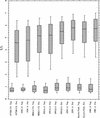Evaluation of the effects of strain-specific antigen variation on the accuracy of serologic diagnosis of Helicobacter pylori infection
- PMID: 12682133
- PMCID: PMC153909
- DOI: 10.1128/JCM.41.4.1480-1485.2003
Evaluation of the effects of strain-specific antigen variation on the accuracy of serologic diagnosis of Helicobacter pylori infection
Erratum in
- J Clin Microbiol. 2003 Jul;41(7):3462. Fukada, Y [corrected to Fukuda, Y]
Abstract
It has been suggested that enzyme immunoassay (EIA) kits validated in one region may yield variable diagnostic performance results in different regions, possibly due to strain-specific differences in antibody responses in different populations. We tested (13)C-urea breath test-characterized serum samples from 109 U.S. patients and 288 Japanese patients using enzyme immunoassay with different preparations of high-molecular-weight cell-associated (HM-CAP) antigens that are conserved across Helicobacter pylori strains. Replicate antigens were prepared from five H. pylori clinical isolates. Eight antigen preparations were evaluated: two of U.S. origin and six of Japanese origin. The accuracies achieved with the eight antigen preparations ranged from 94.4 to 96.3% with the U.S. samples. With the Japanese samples the accuracies achieved ranged from 92.3 to 97.2%. Use of a pool of HM-CAP antigens prepared from isolates from Japan resulted in a higher median enzyme immunoassay value and slightly fewer samples with indeterminate results compared to the results obtained by use of the U.S. standard HM-CAP antigen for H. pylori-positive patients (accuracies, 97.2 and 92.3%, respectively), suggesting that variations in performance between both antigen source and patient population might be reduced by using antigens pooled from several strains.
Figures
Similar articles
-
A strain-specific antigen in Japanese Helicobacter pylori recognized in sera of Japanese children.Clin Diagn Lab Immunol. 2005 Nov;12(11):1280-4. doi: 10.1128/CDLI.12.11.1280-1284.2005. Clin Diagn Lab Immunol. 2005. PMID: 16275941 Free PMC article.
-
Evaluation of three commercial enzyme immunoassays compared with the 13C urea breath test for detection of Helicobacter pylori infection.J Clin Microbiol. 1996 May;34(5):1147-52. doi: 10.1128/jcm.34.5.1147-1152.1996. J Clin Microbiol. 1996. PMID: 8727892 Free PMC article.
-
Prospective, study comparing the accuracy of two different stool antigen tests (Premier Platinum HpSA and novel ImmunoCard STAT! rapid test) for the diagnosis of Helicobacter pylori infection.Gastroenterol Hepatol. 2020 Mar;43(3):117-125. doi: 10.1016/j.gastrohep.2019.09.009. Epub 2019 Dec 4. Gastroenterol Hepatol. 2020. PMID: 31810793 Clinical Trial. English, Spanish.
-
[Helicobacter pylori IgG antibody, urea breath test, Helicobacter pylori antigen in the stool].Nihon Rinsho. 2005 Jul;63 Suppl 7:175-9. Nihon Rinsho. 2005. PMID: 16111220 Review. Japanese. No abstract available.
-
Serological methods for diagnosis of Helicobacter pylori infection and monitoring of eradication therapy.Eur J Clin Microbiol Infect Dis. 2000 Mar;19(3):164-73. doi: 10.1007/s100960050454. Eur J Clin Microbiol Infect Dis. 2000. PMID: 10795588 Review.
Cited by
-
The chimeric UreB, FliD and Omp18 proteins for a sensitive and specific diagnosis of Helicobacter pylori infections.Iran J Microbiol. 2024 Jun;16(3):357-365. doi: 10.18502/ijm.v16i3.15768. Iran J Microbiol. 2024. PMID: 39005599 Free PMC article.
-
A strain-specific antigen in Japanese Helicobacter pylori recognized in sera of Japanese children.Clin Diagn Lab Immunol. 2005 Nov;12(11):1280-4. doi: 10.1128/CDLI.12.11.1280-1284.2005. Clin Diagn Lab Immunol. 2005. PMID: 16275941 Free PMC article.
-
Seroprevalence of Helicobacter pylori infection in urban and rural Vietnam.Clin Diagn Lab Immunol. 2005 Jan;12(1):81-5. doi: 10.1128/CDLI.12.1.81-85.2005. Clin Diagn Lab Immunol. 2005. PMID: 15642989 Free PMC article.
-
Analysis of negative result in serum anti-H. pylori IgG antibody test in cases with gastric mucosal atrophy.J Clin Biochem Nutr. 2016 Sep;59(2):145-148. doi: 10.3164/jcbn.16-13. Epub 2016 Jun 10. J Clin Biochem Nutr. 2016. PMID: 27698543 Free PMC article.
-
Non-invasive diagnostic tests for Helicobacter pylori infection.Cochrane Database Syst Rev. 2018 Mar 15;3(3):CD012080. doi: 10.1002/14651858.CD012080.pub2. Cochrane Database Syst Rev. 2018. PMID: 29543326 Free PMC article.
References
-
- Atherton, J., and A. Covacci. 1997. Pathogenic properties of Helicobacter pylori. Curr. Opin. Gastroenterol. 13:20-24.
-
- Blaser, M. J. 1994. Helicobacter pylori phenotypes associated with peptic ulceration. Scand. J. Gastroenterol. 29:1-5. - PubMed
-
- Borba de Arruda, S. M., D. J. Passaro, S. Yang, and J. Parsonnet. 2001. Variability of serologic testing for H. pylori using U.S. and Peruvian antigens. Gastroenterology 120:325-326. - PubMed
-
- Chen, X., K. Haruma, T. Kamada, M. Mihara, K. Komoto, M. Yashihara, K. Sumii, and G. Kajiyama. 2000. Factors that affect results of the 13C urea breath test in Japanese patients. Helicobacter 5:98-103. - PubMed
Publication types
MeSH terms
Substances
LinkOut - more resources
Full Text Sources
Medical
Miscellaneous



